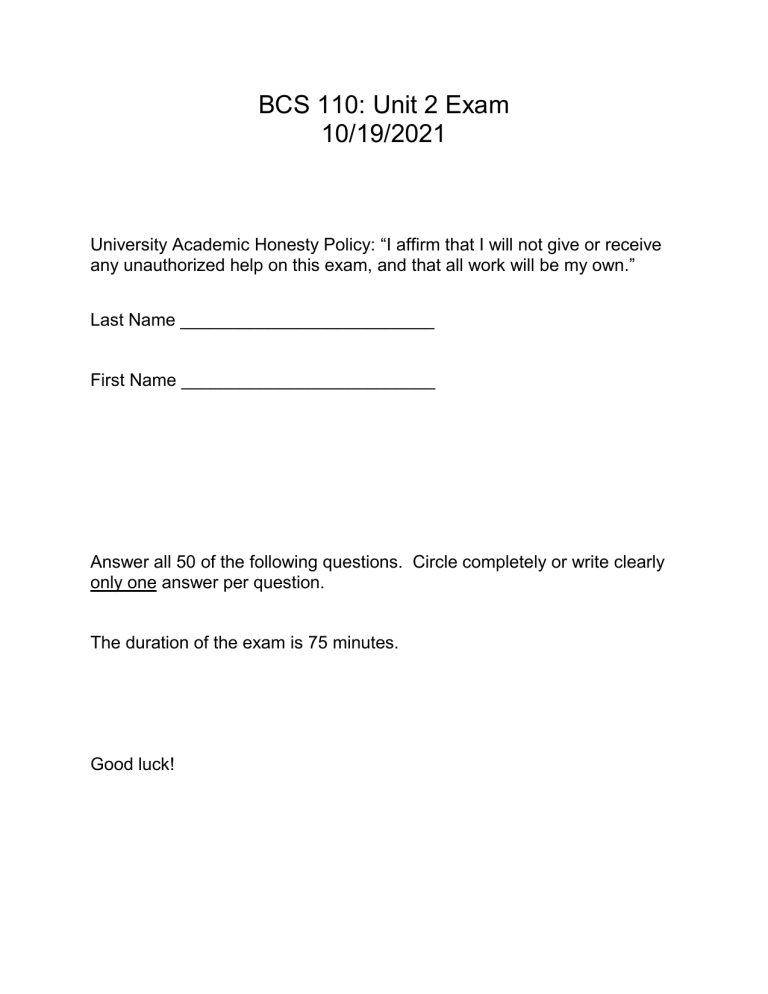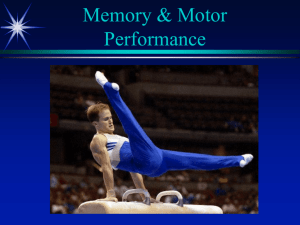
BCS 110: Unit 2 Exam 10/19/2021 University Academic Honesty Policy: any unauthorized help on this exam, and that all Last Name __________________________ First Name __________________________ Answer all 50 of the following questions. Circle completely or write clearly only one answer per question. The duration of the exam is 75 minutes. Good luck! 1) In comparison to the scotopic system, the photopic system has A) more receptors in the retina B) higher sensitivity to light C) greater neural convergence D) stronger lateral inhibition E) none of the above 2) The basilar membrane vibrates most strongly to _____ pure tones at its apex, and it is the activity of _____ hair cells that increases the motion of the membrane. A) low frequency; inner B) low frequency; outer C) high frequency; inner D) high frequency; outer 3) Which somatosensory receptor type signals that you have just received a light tap on the shoulder? A) Merkel B) Pacinian C) Meissner D) Ruffini 4) Which of the following pairs of sensory systems use opposite methods of both signal transduction and transmission? A) gustation-vision B) vision-olfaction C) olfaction-audition D) audition-gustation 5) A patient has difficulty moving the toes on their left foot. You suspect damage to the ______ side of the spinal cord at ______. A) contralateral, one level B) ipsilateral, one level C) contralateral, multiple levels D) ipsilateral, multiple levels 6) Sensory systems often process information in a push-pull fashion: that is, when one neuron is stimulated by a given stimulus, its corresponding partner is inhibited, and vice versa when the stimulus is changed to its opposite. Push-pull processing is evident in the central nervous system of which of the following senses? A) auditory B) olfactory C) vision D) somatosensory E) gustatory 2 7) In the visual system, parvocellular is to magnocellular as A) left is to right eye B) black-and-white is to color C) on-center is to off-center cells D) small is to large receptive fields E) none of the above 8) Scene analysis is the process by which the human auditory system organizes sounds into perceptually distinct sources. Which property of a sound source is computed first, and to which stream does it contribute? A) identity, dorsal B) identity, ventral C) location, dorsal D) location, ventral 9) The excess of movement by _____ through the basal ganglia. isease is caused A) a decrease in activity in the D1 pathway B) an increase in activity in the D1 pathway C) a decrease in activity in the D2 pathway D) an increase in activity in the D2 pathway 10) In response to photons of light in the center of their receptive field, off-center bipolar cells become _____ permeable to _____ ions. A) less, sodium B) more, sodium C) less, potassium D) more, potassium For the sets below, match each phrase on the left with a single corresponding response on the right. Write your answer on the line in front of the number. Some responses may be used multiple times, others not at all. With regard to sensory receptors: initial transduction mechanism and ion that ultimately carries the vast majority of the current (in or out) (answers graded independently) Mech Ion (A-D) (J-N) ____ ____ 11) smelling a flower ____ ____ 12) feeling pain from a fall ____ ____ 13) looking at a painting ____ ____ 14) tasting a sour lemon ____ ____ 15) maintaining balance Mechanism Ion A) enter through open channels J) calcium B) push open ion channels C) pull open ion channels D) activate G-protein K) potassium L) chloride M) sodium N) hydrogen 3 With regard to sensory and motor pathways through thalamic nuclei: structures in the ascending pathway and cortical target lobe (responses graded independently) Path Lobe (A-F) (J-M) ____ ____ 16) ventral anterior ____ ____ 17) dorsomedial ____ ____ 18) ventral posterior ____ ____ 19) medial geniculate ____ ____ 20) ventral lateral In Path Target lobe A) semicircular canals B) inferior olive C) retina D) olfactory bulb E) globus pallidus J) temporal K) frontal L) occipital M) parietal F) superior olive With regard to the information carried in different spinal cord pathways: _____ 21) playing piano _____ 22) making you look _____ 23) reducing sensation of a paper-cut _____ 24) knowing that your arm is raised _____ 25) bending down at the waist With regard to structure/function relationships in sensory and motor systems: _____ 26) non-distorted, labeled-line sensory cortex _____ 27) ability to make a requested movement _____ 28) relays (not makes) motor correction signals _____ 29) depth perception _____ 30) sense of taste _____ 31) exteroception _____ 32) mirror neurons _____ 33) sets overall plan of action _____ 34) audiovisual speech perception (multisensory McGurk effect) _____ 35) votes on specific set of instructions 4 With regard to structure/dysfunction relationships in sensory and motor systems: _____ 36) _____ 37) loss of smell _____ 38) abnormal gait (walking) _____ 39) blindness _____ 40) inability to taste/vomit 41) The receptive fields of layer IV simple cells are roughly ______ in shape, and driven by inputs from ______ eye(s). A) circular, one B) circular, two C) rectangular, one D) rectangular, two 42) A neurological patient has selective bilateral damage to her ventral visual streams. It is likely that she has A) no difficulty describing the color of an object. B) great difficulty describing the location of a visual target in space. C) no difficulty reaching out and grabbing an object under visual control. D) great difficulty seeing in dim illumination. 43) A fast motor unit consists of a motor neuron and all of the _____ fibers it innervates _____ blood vessels. A) extrafusal, near to B) extrafusal, far from C) intrafusal, near to D) intrafusal, far from 44) Sensory receptors may or may not have axons that project into the CNS. Of the following receptor types (pain, touch, vision, olfactory, and temperature), how many lack axons? A) one B) two C) three D) four E) five 5 45) The somatosensory system is characterized by systems having both fast and slow receptors, which are sensitive to initial and on-going stimulation, respectively. Which of the following systems is an exception to this rule? A) balance B) touch C) muscles D) joints E) pain 46) Olfactory and gustatory receptors are similar in some ways, but different in other ways. How do olfactory receptors differ from gustatory receptors? A) They are replaced regularly. B) They express one type of receptor protein. C) They respond to many stimuli. D) They are organized in a random (ie. not chemotopic) manner. E) None of the above 47) The sensory receptors of the vestibular system do not respond to A) sudden head tilt (i.e., looking up) B) head tilt that is maintained for over a minute C) sudden head rotation towards one side (i.e., looking to the right) D) body rotation that is maintained for over a minute 48) The neurons with the longest neurons in the human body are part of the _____ system. A) touch B) pain C) motor D) balance 49) A patient visits the doctor complaining of visual disturbances. Upon examination, it is determined that the patient is experiencing a complete loss of vision for stimuli in the periphery of visual space (i.e., they can see fine looking only straight ahead). The site of damage is most likely to be at which point in the visual pathway? A) optic nerve B) optic chiasm C) optic track D) optic radiation 50) Association cortex is at the top of the hierarchy for _____. A) the sensory systems B) the motor system C) both sensory and motor systems D) neither sensory nor motor systems 6


